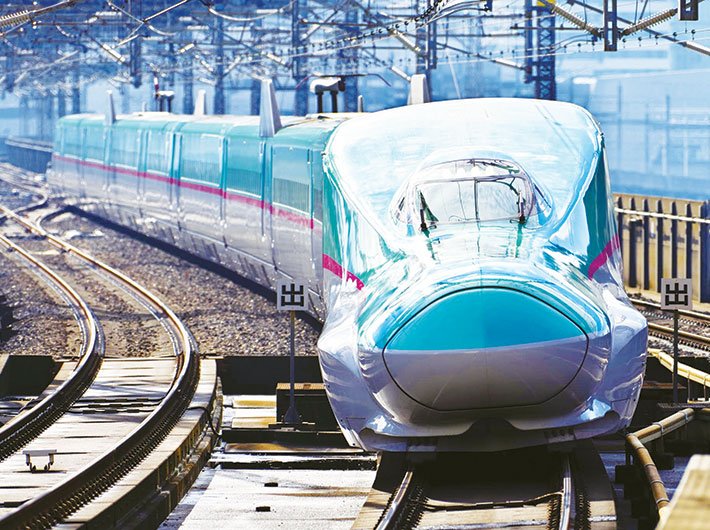If India is to launch its first bullet train in five years, it will need meticulous planning to meet a series of challenges
If all goes well, India’s first high-speed train would zip by in December 2023. In fact, railways minister Piyush Goyal is even confident that the 508-km Ahmedabad-Mumbai high-speed rail (HSR) project would be completed much before that, by August 2022 – on the country’s 75th independence anniversary. It remains to be seen if the National High Speed Rail Corporation Limited (NHSRCL), the executing agency of the project, would be able to meet either of the deadlines.
Many former railway board members and some railway experts believe that it would be unfair to expect the NHRCL to launch the project before the deadline due to a plethora of challenges like working on the new Shinkansen HSR technology.
READ: Why bullet trains are unsuitable for India
Railway officials say it is one thing to set up multiple deadlines on paper and quite another thing to execute them; meticulous planning is needed to accomplish the target.
Also, questions are being raised whether the bullet train would be able to get thousands of passengers daily to make the project financially viable. As per a report by the IIM Ahmedabad, the high-speed train requires 90,000-1,20,000 passengers per day to make it financially viable.
Key features
Length 508 km, double-line through Maharashtra (156 km) and Gujarat (351 km) and UT of Dadra and Nagar Haveli (2 km)
Longest tunnel of 21 km including undersea tunnel of 7 km (Thane Creek)
12 stations: Mumbai, Thane, Virar, Boisar, Vapi, Bilimora, Surat, Bharuch, Vadodara, Anand, Ahmedabad and Sabarmati. The only underground station will be in Mumbai, others elevated.
Maximum design speed: 350 kmph
Maximum operating speed: 320 kmph
Journey time: 2.07 hrs (limited stops), 2.58 hrs (stopping at stations) vis-a-vis existing train travel time of 7-8 hours
Some facts about Mumbai-Ahmedabad HSR
Project cost estimated at '1,08,000 crore. Nearly entire corridor elevated for safety and land economy
81% of the project cost borne by the Japanese soft loan at 0.1% per annum with repayment period 50 years, including grace period of 15 years.
Four sub-groups with representatives from the Indian and Japanese industry, DIPP, NHSRCL and JETRO will identify potential items or activities for Make in India initiative
High Speed Rail Training Institute at Vadodara to train 4,000 staff for operations and maintenance
The project will create 20,000 construction jobs. There will be 4,000 direct jobs for operations and 20,000 indirect jobs
Shinkansen technology will be used, known for reliability and safety with proven track record of more than 50 years
Punctuality record for the technology is less than a minute with zero fatality since its launch in 1964 in Japan
Project comes with technical support and handholding of the Japanese. It will ensure complete transfer of know-how to Indians for future projects
It will give a boost to urban and industrial development along the corridor
But a former member (traffic) of the railway board, on condition of anonymity, says, “There is no guarantee that people who commute through road and air would switch to the high-speed train, which is not going to be very cheap. People who have enough time to reach Mumbai from Ahmedabad will avoid paying a hefty fare for the bullet train and would rather travel by a conventional train.”
Agrees Sunil Kumar, former advisor (safety) and additional member, Railway Board. He says that the ridership depends on the fare structure because middle-class people will only use the bullet train if it comes with an attractive fare tag.
“The HSR is not going to be a financially attractive proposition but if the government wants to provide a new technology to the people who can afford it; it is the suitable time,” says the former member (traffic).
READ: Achal Khare, MD, National High Speed Rail Corporation on the bullet train roadmap
He further says that fixing the alignment for the 508-km project itself is a daunting task. Construction work can only begin after the design and plan are prepared, which would take at least two years.
“If everything falls in place, which means getting the material and technical expertise, it would take at least seven years after all preparatory works are done to launch the high-speed train. Land acquisition is a complex issue despite the fact that a majority of the project is on an elevated corridor. Consultations would have to be done with the locals for land acquisition. Social and environmental assessment would also require time,” he adds.
The former member (traffic) also says that the bullet train will not generate profit in its initial years mainly because of the fare and availability of other modes of transportation on the proposed route.
A senior railway official believes that the biggest challenge would be to ensure transfer of technology and promote ‘Make in India’ by manufacturing key components of the bullet train in the country.
“By the time the bullet train will be unveiled a production facility should be established in India, otherwise it would take years to give a push to the ‘Make in India’ initiative. The Japanese have certain reservations on ‘Make in India’ because they intend to promote their own industry. Since, the project depends on a Japanese loan, India is bound for sourcing the components from Japan. In the tenders, only Japanese companies would be able to participate in some of the sectors like rolling stock. There are certain areas where Indian companies would participate. There will be joint ventures between Indian and Japanese companies,” he says.
VN Mathur, former member (traffic), railway board, says that between 2004 and 2017, China had already developed 22,000 km of high-speed rail lines. At present, Morocco is building its HSR network. “Though India is already late in introducing the HSR, it is the apt time to execute it but the authorities will have to execute it meticulously to get the work completed within deadline,” he says.
Sunil Kumar adds, “The alignment is completely new which the Indian Railways has never seen before. Besides, the maintenance cost of the bullet train is going to be very high. To keep any technology snag-free requires intensive work and culture of maintenance.”
Moreover, he adds, NHSRCL needs a person like E Sreedharan to have its first high-speed train by December 2023, which comes with many challenges. “If any legal issue comes up for land acquisition, it has to be expeditiously resolved, otherwise the deadline would get affected. Elevated corridors reduce the requirement of land but resettlement of affected people often takes time,” Kumar says.
vishwas@governancenow.com
(The article appears in the October 31, 2017 issue)

